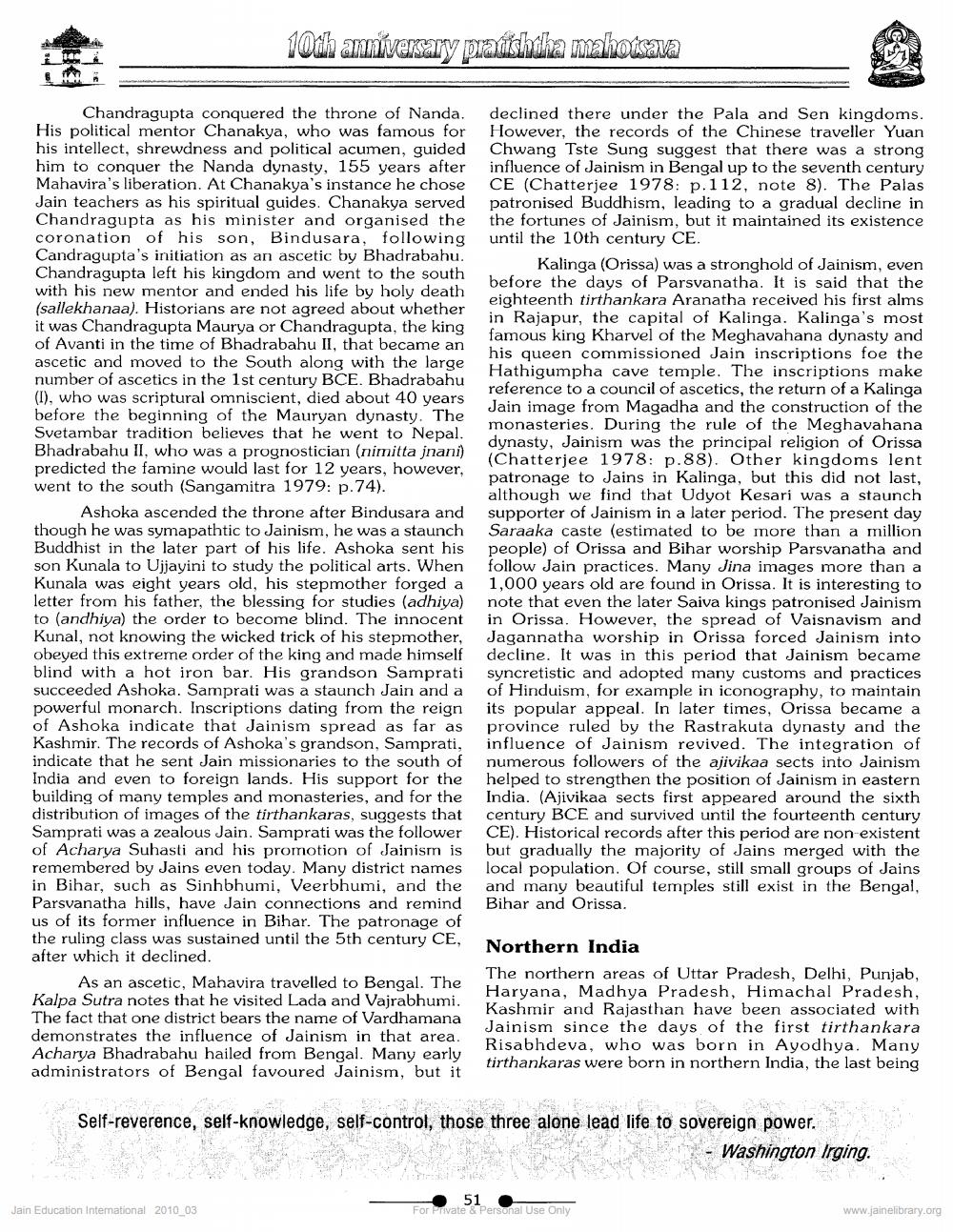________________
10th anniversary pratishdia mahotsava
Chandragupta conquered the throne of Nanda. His political mentor Chanakya, who was famous for his intellect, shrewdness and political acumen, guided him to conquer the Nanda dynasty, 155 years after Mahavira's liberation. At Chanakya's instance he chose Jain teachers as his spiritual guides. Chanakya served Chandragupta as his minister and organised the coronation of his son, Bindusara, following Candragupta's initiation as an ascetic by Bhadrabahu. Chandragupta left his kingdom and went to the south with his new mentor and ended his life by holy death (sallekhanaa). Historians are not agreed about whether it was Chandragupta Maurya or Chandragupta, the king of Avanti in the time of Bhadrabahu II, that became an ascetic and moved to the South along with the large number of ascetics in the 1st century BCE. Bhadrabahu (1), who was scriptural omniscient, died about 40 years before the beginning of the Mauryan dynasty. The Svetambar tradition believes that he went to Nepal. Bhadrabahu II, who was a prognostician (nimitta jnani) predicted the famine would last for 12 years, however, went to the south (Sangamitra 1979: p.74).
Ashoka ascended the throne after Bindusara and though he was symapathtic to Jainism, he was a staunch Buddhist in the later part of his life. Ashoka sent his son Kunala to Ujjayini to study the political arts. When Kunala was eight years old, his stepmother forged a letter from his father, the blessing for studies (adhiya) to (andhiya) the order to become blind. The innocent Kunal, not knowing the wicked trick of his stepmother, obeyed this extreme order of the king and made himself blind with a hot iron bar. His grandson Samprati succeeded Ashoka. Samprati was a staunch Jain and a powerful monarch. Inscriptions dating from the reign of Ashoka indicate that Jainism spread as far as Kashmir. The records of Ashoka's grandson, Samprati, indicate that he sent Jain missionaries to the south of India and even to foreign lands. His support for the building of many temples and monasteries, and for the distribution of images of the tirthankaras, suggests that Samprati was a zealous Jain. Samprati was the follower of Acharya Suhasti and his promotion of Jainism is remembered by Jains even today. Many district names in Bihar, such as Sinhbhumi, Veerbhumi, and the Parsvanatha hills, have Jain connections and remind us of its former influence in Bihar. The patronage of the ruling class was sustained until the 5th century CE, after which it declined.
As an ascetic, Mahavira travelled to Bengal. The Kalpa Sutra notes that he visited Lada and Vajrabhumi. The fact that one district bears the name of Vardhamana demonstrates the influence of Jainism in that area. Acharya Bhadrabahu hailed from Bengal. Many early administrators of Bengal favoured Jainism, but it
Jain Education International 2010_03
declined there under the Pala and Sen kingdoms. However, the records of the Chinese traveller Yuan Chwang Tste Sung suggest that there was a strong influence of Jainism in Bengal up to the seventh century CE (Chatterjee 1978: p.112, note 8). The Palas patronised Buddhism, leading to a gradual decline in the fortunes of Jainism, but it maintained its existence until the 10th century CE.
Kalinga (Orissa) was a stronghold of Jainism, even before the days of Parsvanatha. It is said that the eighteenth tirthankara Aranatha received his first alms in Rajapur, the capital of Kalinga. Kalinga's most famous king Kharvel of the Meghavahana dynasty and his queen commissioned Jain inscriptions foe the Hathigumpha cave temple. The inscriptions make reference to a council of ascetics, the return of a Kalinga Jain image from Magadha and the construction of the monasteries. During the rule of the Meghavahana dynasty, Jainism was the principal religion of Orissa (Chatterjee 1978: p.88). Other kingdoms lent patronage to Jains in Kalinga, but this did not last, although we find that Udyot Kesari was a staunch supporter of Jainism in a later period. The present day Saraaka caste (estimated to be more than a million people) of Orissa and Bihar worship Parsvanatha and follow Jain practices. Many Jina images more than a 1,000 years old are found in Orissa. It is interesting to note that even the later Saiva kings patronised Jainism in Orissa. However, the spread of Vaisnavism and Jagannatha worship in Orissa forced Jainism into decline. It was in this period that Jainism became syncretistic and adopted many customs and practices of Hinduism, for example in iconography, to maintain its popular appeal. In later times, Orissa became a province ruled by the Rastrakuta dynasty and the influence of Jainism revived. The integration of numerous followers of the ajivikaa sects into Jainism helped to strengthen the position of Jainism in eastern India. (Ajivikaa sects first appeared around the sixth century BCE and survived until the fourteenth century CE). Historical records after this period are non-existent but gradually the majority of Jains merged with the local population. Of course, still small groups of Jains and many beautiful temples still exist in the Bengal, Bihar and Orissa.
Northern India
The northern areas of Uttar Pradesh, Delhi, Punjab, Haryana, Madhya Pradesh, Himachal Pradesh, Kashmir and Rajasthan have been associated with Jainism since the days of the first tirthankara Risabhdeva, who was born in Ayodhya. Many tirthankaras were born in northern India, the last being
Self-reverence, self-knowledge, self-control, those three alone lead life to sovereign power.
Washington Irging.
51
For Private & Personal Use Only
www.jainelibrary.org




